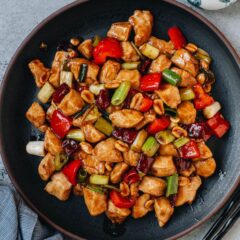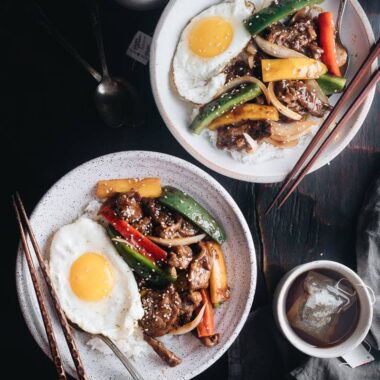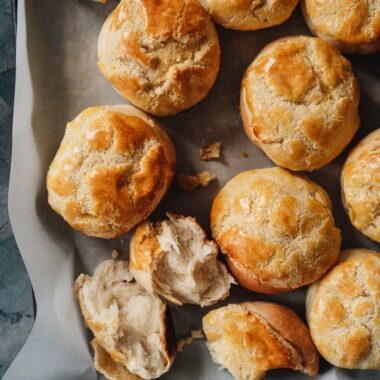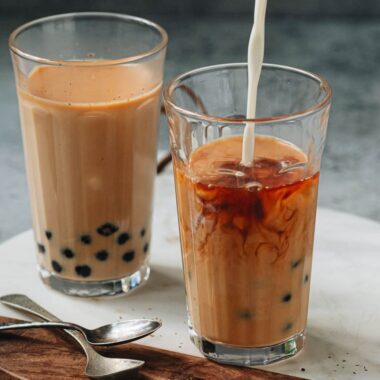
If you’ve ever dined at a Chinese restaurant, chances are you’ve come across Kung Pao Chicken (宫保鸡丁), a dish that’s beloved for its bold, punchy flavors. One of the most famous dishes from Sichuan cuisine, this stir-fry has found its way onto menus worldwide, thanks to its irresistible combination of heat, sweetness, and savoriness, with ingredients featuring various textures. Whether you’re a fan of Chinese food or simply love trying new dishes, Kung Pao Chicken should be on your next dinner menu.
The magic of Kung Pao Chicken lies in its balance of flavors and textures. It’s spicy and savory, yet subtly sweet and sour. It is colorful and packed with crunchy peanuts and vegetables. Each bite offers a complex experience that’s deeply satisfying. At the heart of the dish is its Sichuan peppercorn, which adds a distinct numbing sensation known as “mala” — a hallmark of Sichuan cuisine.

Ingredients for making kung pao chicken
There are many factors to consider if you want to successfully execute Kung Pao chicken in your own kitchen. The chicken is tender and juicy. The peanuts are crispy. The vegetables are vibrantly colored and crunchy. An extremely aromatic sauce coats the ingredients. The dish is bursting with flavor, yet not too sweet, spicy, or sour.
What cut of chicken to use
The real-deal kung pao chicken uses exclusively skinless breasts, but you can use thighs, as well. Chicken breasts require a little more precision when cooking, to keep the meat very tender and juicy without overcooking. Chicken thigh is more forgiving and yields a more flavorful result (if that is your goal with the dish). I also found chicken tenderloin to be a great option as well, because it yields an even tenderer result.
Chinese dried chili pepper
Chinese dried chili pepper adds a ton of umami to kung pao chicken without adding too much heat. For a spicier dish, you can cut the dried chili pepper into 3 to 4 pieces and include the seeds in the stir fry.
To achieve the delightful red color of the dish, my favorite way is to add less dried chili pepper at the beginning of cooking, and use a small amount of homemade chili oil at the end. This way you can control the spice level and add an extra layer of flavor to the dish.
Check out The Mala Market for high quality Facing Heaven Dried Chili Peppers from Sichuan.
Sichuan peppercorn
Sichuan peppercorn (花椒, Hua Jiao) is a signature ingredient in many Sichuan dishes, including kung pao chicken. It has a bright, citrusy and floral aroma and flavor. Once eaten, the pepper explodes, with a vibrant numbing tingling sensation throughout the mouth. This sensation makes the rest of the ingredients take on a new character as well.
The Mala Market carries my favorite Sichuan peppercorns because they are super fresh and extra potent.
Mise en place
This is the most important step when it comes to stir-frying. Because you will work with the highest heat, the cooking will be finished in mere minutes. This means you won’t have time to hesitate and fetch ingredients from the cabinet. All the ingredients should be ready and laid out near your stir frying station:
- Marinated chicken
- Mixed sauce
- Chopped spices and aromatics (ginger, garlic, dried chili pepper, Sichuan peppercorns)
- Diced pepper
- Diced green onion
- Peanuts


This recipe uses a moderate amount of sauce, just enough to coat the chicken. Be generous with aromatics, especially green onion and garlic. Cooked green onion is tender and sweet. It adds a nice texture and flavor to the chicken. Green onion is a prominent ingredient and every single bite should contain some of it.
In China, lots of restaurants actually use diced cucumber in kung pao chicken to add a crisp, crunchy texture. Many of my American friends found cooked cucumber quite strange, so I opted to replace it with red pepper, which creates a similar effect.
How to make kung pao chicken
Making kung pao chicken is very straightforward once you have all the ingredients prepared:
- Sear the chicken until just cooked, then transfer to a plate (to prevent overcooking)
- Saute the aromatics and spices
- Cook the red pepper
- Add the green onion and give it a quick stir
- Cook the sauce until it thickens
- Add back the cooked chicken
- Add the peanuts
- Stir everything together

One word about the peanuts
If you fry the peanuts with a small amount of oil and let them cool completely, they will become extra crispy. I did not include this step in the recipe, but Chinese restaurants usually do this prior to the stir-fry to maximize the crispiness of the peanuts. If you’re cooking a dish to entertain guests, do this for best results. For everyday cooking, skip it, because it is quite time-consuming.
Do I need a wok for kung pao chicken?
To create the best texture and impart a smokiness to the dish, you need to use a wok and cook with extremely high heat. However, I’ve discussed in the Wok vs. Stir Frying Pan post that many home kitchens in the US are not suitable for wok cooking. If you have an electric stove, induction stove, or a typical gas stove (not very powerful), consider using a large nonstick skillet to make kung pao chicken. You won’t get the wok hei (smoky taste) but the taste of the dish will remain delicious.
I usually don’t use a carbon steel or cast iron pan for making kung pao chicken, because the sauce contains vinegar. It might unseason your pan if your pan is relatively new or if you let the sauce stay in the skillet too long.
How to serve kung pao chicken
Kung pao chicken tastes perfect when served on freshly steamed white rice. You can also serve the dish as one of the main dishes of a multi-course meal.
Consider to serve these dishes below for a balanced Sichuan dinner:
- Mapo Tofu (麻婆豆腐)
- Dan Dan Noodles (担担面)
- Stir-Fried Pea Shoots with Garlic (蒜蓉炒豆苗)
- Yu Xiang Eggplant (鱼香茄子, Sichuan Eggplant Stir Fry)
- Sichuan Dry Fried Green Beans (干煸四季豆)
- Fu Qi Fei Pian (Sichuan Sliced Beef in Chili Sauce, 夫妻肺片)
When serving Sichuan food, it’s important to have various types of dishes that are less spicy or non-spicy, to balance out the meal and clean your palate.

More delicious stir fry recipes
- Sweet and Sour chicken
- Black Pepper Steak
- Eggplant in Garlic Sauce
- Scallion Beef Stir Fry
- General Tso’s Tofu
Chinese Cooking Made Easy
Are you new to this website? This free email series is a great place to start. I’ll walk you through a few of my most popular recipes and show you how and why they work. You’ll quickly start to cook better Chinese food in your own kitchen.

Kung Pao Chicken (宫保鸡丁)
Ingredients
- 1 lb (450 g) boneless skinless chicken breast , diced into 3/4” (1.5 cm) pieces (or thigh)
Marinade
- 1 tablespoon light soy sauce (or soy sauce)
- 2 teaspoons Shaoxing wine
- 1 tablespoon cornstarch
Sauce
- 2 tablespoons chicken broth
- 2 tablespoons Chinkiang vinegar (or rice vinegar)
- 1 tablespoon Shaoxing wine
- 1 tablespoon light soy sauce (or soy sauce)
- 1/2 tablespoon dark soy sauce
- 2 tablespoons sugar
- 2 teaspoons cornstarch
- 1/4 teaspoon salt
Stir-fry
- 3 tablespoons peanut oil (or vegetable oil)
- 4 cloves garlic , sliced
- 1 thumb ginger , julienned
- 6 red dried Chinese chili peppers , cut into 3 pieces
- 1/4 teaspoon ground Sichuan peppercorns
- 1 red pepper , diced
- 5 large green onions , cut into 1” (2.5 cm) pieces
- 1/3 cup roasted peanuts
- 2 teaspoons chili oil (Optional, to add color)
Instructions
- Combine the chicken and marinade ingredients in a small bowl. Mix well by hand and let marinate for at least 10 minutes, up to 30 minutes.
- Mix all the sauce ingredients together in a medium bowl.
- Heat 1 tablespoon of oil in a large skillet over medium-high heat until hot. Swirl the pan and let oil coat the bottom.
- When the oil is hot, spread chicken in a layer and cook for 20 to 30 seconds without moving it. Cook and stir until the chicken turns just white on the surface and the inside is still slightly raw. Turn to medium-low heat and immediately transfer chicken to a plate.
- Add the remaining 2 tablespoons of oil, garlic, ginger, dried chili peppers, and ground Sichuan peppercorn. Turn to medium heat. Stir and cook until very fragrant.
- Turn to medium-high heat. Add the pepper. Cook and stir for 1 minute. Then add the green onion, Stir and cook for another minute.
- Mix the sauce again so that cornstarch dissolves completely. Swirl in sauce and quickly stir a few times. Add back the cooked chicken. Stir and toss until the sauce thickens. Add the roasted peanuts. Stir again to mix well. Immediately transfer to a plate. Serve warm with steamed white rice.
Video
Nutrition
Have a question or feedback? Add a Comment
Did you make this? I want to see! Tag @OmnivoresCookbook on Instagram, and rate the recipe below.




TJH
I love all your recipes, but this was sooooo delicious. I love Kung Pao but haven’t had it years because way too spicy for me these days. So, I thought, let me give this a try since I can control that. I made the chili oil, but since didn’t have vegetable, used Peanut oil. I cut all the dried Szechuan chilis in half and removed most seeds. (I wiped my eye afterwards, and that’s another story. LOL. Baking soda paste is your best friend!) I made my own crushed pepper and only put half in the chili oil recipe. I also didn’t add the 6 chilis because even though the package said mild, was a bit scared since I had baking soda paste on my face for a couple of hours. Everyone loved it. It was perfect and the Szechuan peppercorns did exactly what you said! I can’t handle big black peppercorn, but these were fabulous! A whole new world. THANK YOU!!
Maggie Zhu
I’m so happy to hear you enjoyed the dish! Re removing the chili pepper seeds – if you cut the top end, you should be able to dump the seeds out without touching them. And it’s also totally possible to use the whole dried chili pepper. The dish will be milder if the seeds are not exposed.
Thanks so much for sharing your experience and leaving a positive review 🙂
Patrick
I made this two days ago and it turned out great. Just enough heat with the recommended amount of chilis. The only thing I did that wasn’t specified in the recipe was grind up the Sichuan peppers. I could feel the tingle on my lips and tongue while eating.
Judy Der
Delicious! My Chinese daughter in law loved it too!
Diane
I made this recipe this week and we absolutely loved it. Much better than our local takeaway. I had everything in the house (Spain) except the Chinese dried chillies so I used dried cayenne chillies and cut them in two or three pieces and left the seeds in. The dish had a bit of a kick but not over the top and we will definitely be making this again and again. Thank you for sharing your wonderful recipes. Everything we have tried has turned out to be amazing!
Joanne Scheel
I enjoy every one of your recipes thank you.
Lonnell Branch
This is a magic recipe. The pepper dances around the mouth. Thanks for this low sodium gem of a meal.
Meagan
Delicious! I used ~3/4 lb. boneless, skinless chicken thigh and added more vegetables. The sauce was perfect.
Sandra G.
I made this for my son because he loves Kung Pao Chicken. It was delicious and he was amazed that I could cook this. Thank you so much for the recipe. I love your recipes.
v
Thank you for posting such good and authentic chinese recipes on the internet. I have tried a number of them with great success and I find your website an invaluable resource for someone looking to dive into chinese cooking. This recipe in particular is the one that I cook over and over again. I’ve cooked it so many times that I don’t even need to look at the recipe anymore. The birds of a feather kung pao is my favorite, but I haven’t ordered it since cooking this recipe.
Kernan
Your recipes were one of the bright spots about living through the pandemic. I’m finally confident cooking Chinese food. Now I can make variations that work. Zucchini is a great addition to this recipe with the green pepper. Thanks again for making it all so easy to follow and introducing me to techniques that make all the difference.
Hendrik
A full pound of meat for just 2 servings, really?
Maggie Zhu
Sorry for the confusion. The recipe yields 2 to 4 servings. I updated the website recently and some information didn’t get transferred properly.
Suzanne
We have now made this three times. We absolutely love this dish and have worked it into our regular meal rotation. We make it exactly as described except we add a bit of ground up Szechuan peppercorns (prepped as you described in Dan Dan noodle recipe- fried and ground up) ). We made this addition because loved the flavour of the missed whole peppercorns in the stir fry but not their grittiness. The fried peppercorns removed from the oil in the first part of the recipe are ground up in our spice grinder and added to refrigerated jar for the next batch or for addition to Dan Dan noodles.